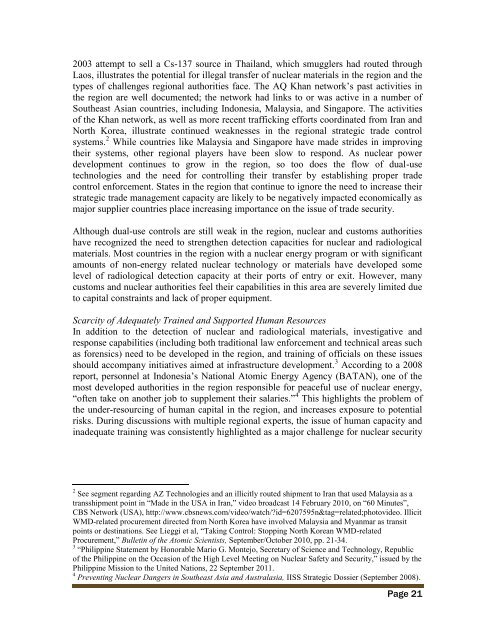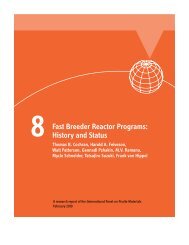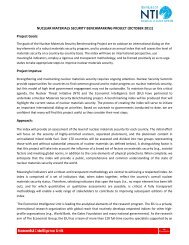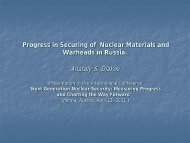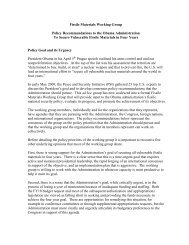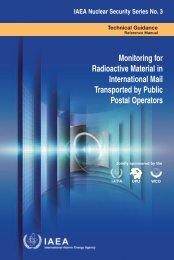Prospects for Nuclear Security Partnership in Southeast Asia - CNS
Prospects for Nuclear Security Partnership in Southeast Asia - CNS
Prospects for Nuclear Security Partnership in Southeast Asia - CNS
You also want an ePaper? Increase the reach of your titles
YUMPU automatically turns print PDFs into web optimized ePapers that Google loves.
2003 attempt to sell a Cs-137 source <strong>in</strong> Thailand, which smugglers had routed throughLaos, illustrates the potential <strong>for</strong> illegal transfer of nuclear materials <strong>in</strong> the region and thetypes of challenges regional authorities face. The AQ Khan network’s past activities <strong>in</strong>the region are well documented; the network had l<strong>in</strong>ks to or was active <strong>in</strong> a number of<strong>Southeast</strong> <strong>Asia</strong>n countries, <strong>in</strong>clud<strong>in</strong>g Indonesia, Malaysia, and S<strong>in</strong>gapore. The activitiesof the Khan network, as well as more recent traffick<strong>in</strong>g ef<strong>for</strong>ts coord<strong>in</strong>ated from Iran andNorth Korea, illustrate cont<strong>in</strong>ued weaknesses <strong>in</strong> the regional strategic trade controlsystems. 2 While countries like Malaysia and S<strong>in</strong>gapore have made strides <strong>in</strong> improv<strong>in</strong>gtheir systems, other regional players have been slow to respond. As nuclear powerdevelopment cont<strong>in</strong>ues to grow <strong>in</strong> the region, so too does the flow of dual-usetechnologies and the need <strong>for</strong> controll<strong>in</strong>g their transfer by establish<strong>in</strong>g proper tradecontrol en<strong>for</strong>cement. States <strong>in</strong> the region that cont<strong>in</strong>ue to ignore the need to <strong>in</strong>crease theirstrategic trade management capacity are likely to be negatively impacted economically asmajor supplier countries place <strong>in</strong>creas<strong>in</strong>g importance on the issue of trade security.Although dual-use controls are still weak <strong>in</strong> the region, nuclear and customs authoritieshave recognized the need to strengthen detection capacities <strong>for</strong> nuclear and radiologicalmaterials. Most countries <strong>in</strong> the region with a nuclear energy program or with significantamounts of non-energy related nuclear technology or materials have developed somelevel of radiological detection capacity at their ports of entry or exit. However, manycustoms and nuclear authorities feel their capabilities <strong>in</strong> this area are severely limited dueto capital constra<strong>in</strong>ts and lack of proper equipment.Scarcity of Adequately Tra<strong>in</strong>ed and Supported Human ResourcesIn addition to the detection of nuclear and radiological materials, <strong>in</strong>vestigative andresponse capabilities (<strong>in</strong>clud<strong>in</strong>g both traditional law en<strong>for</strong>cement and technical areas suchas <strong>for</strong>ensics) need to be developed <strong>in</strong> the region, and tra<strong>in</strong><strong>in</strong>g of officials on these issuesshould accompany <strong>in</strong>itiatives aimed at <strong>in</strong>frastructure development. 3 Accord<strong>in</strong>g to a 2008report, personnel at Indonesia’s National Atomic Energy Agency (BATAN), one of themost developed authorities <strong>in</strong> the region responsible <strong>for</strong> peaceful use of nuclear energy,“often take on another job to supplement their salaries.” 4 This highlights the problem ofthe under-resourc<strong>in</strong>g of human capital <strong>in</strong> the region, and <strong>in</strong>creases exposure to potentialrisks. Dur<strong>in</strong>g discussions with multiple regional experts, the issue of human capacity and<strong>in</strong>adequate tra<strong>in</strong><strong>in</strong>g was consistently highlighted as a major challenge <strong>for</strong> nuclear security2 See segment regard<strong>in</strong>g AZ Technologies and an illicitly routed shipment to Iran that used Malaysia as atransshipment po<strong>in</strong>t <strong>in</strong> “Made <strong>in</strong> the USA <strong>in</strong> Iran,” video broadcast 14 February 2010, on “60 M<strong>in</strong>utes”,CBS Network (USA), http://www.cbsnews.com/video/watch/?id=6207595n&tag=related;photovideo. IllicitWMD-related procurement directed from North Korea have <strong>in</strong>volved Malaysia and Myanmar as transitpo<strong>in</strong>ts or dest<strong>in</strong>ations. See Lieggi et al, “Tak<strong>in</strong>g Control: Stopp<strong>in</strong>g North Korean WMD-relatedProcurement,” Bullet<strong>in</strong> of the Atomic Scientists, September/October 2010, pp. 21-34.3 “Philipp<strong>in</strong>e Statement by Honorable Mario G. Montejo, Secretary of Science and Technology, Republicof the Philipp<strong>in</strong>e on the Occasion of the High Level Meet<strong>in</strong>g on <strong>Nuclear</strong> Safety and <strong>Security</strong>,” issued by thePhilipp<strong>in</strong>e Mission to the United Nations, 22 September 2011.4 Prevent<strong>in</strong>g <strong>Nuclear</strong> Dangers <strong>in</strong> <strong>Southeast</strong> <strong>Asia</strong> and Australasia, IISS Strategic Dossier (September 2008).Page 21


